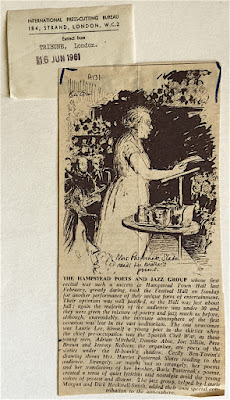Sent in by a regular from Hertfordshire - Robin Healey.
 |
| John Constable -- The Spedding Home |
Less than five minutes into an episode of the recently aired
Fake or Fortune series I pricked up my ears. Fiona Bruce and her art sleuths were discussing the provenance of a putative Constable painting of Yarmouth Harbour when they pronounced the name of a former owner, Jane Spedding.
That rang a very loud bell with me. You see, about 25 years ago I bought a rather battered dissected map of England and Wales, dating to around 1811, from an eccentric old dealer in the Pimlico Road. It was priced at just only £2, and I assumed that its cheapness reflected the fact that it, like many of these early jigsaw puzzles, had many pieces missing. At home I examined it further and discovered that the handwriting in pencil on the bare wood on the reverse of the lid confirmed my suspicions. There were, according to the writer, six pieces missing---‘ Anglesea, Flintshire and Radnor, Surrey, Middlesex and Isle of Wight ’. But there was more information. The writer had appended two names and two addresses: ‘Margaret and Jane Spedding 23, Norfolk Street, London & Hampstead Heath, near London, Middlesex, England’.

The names meant nothing to me then, but fast forward ten or so years later and in some context or other I came across the name of the lawyer Anthony Spedding. He was the legal partner of Constable’s father-in-law Charles Bicknell and owned a town house in Norfolk Street, off the Strand, and a weekend retreat on the Heath. After Constable had settled in Well Walk, Hampstead, he got to know Spedding and his family, ‘(their house is clearly visible in ‘The Road to the ‘Spaniards’), and visited them regularly. In August 1829 Jane Spedding sent Constable’s daughter Emily, then aged four, a present of a doll’s house with a covering letter. After hoping that the gift would give her ‘ dear little Emily ‘as much pleasure as it had given her at the same age, Jane adds that some things in her 'old Baby house' were a little damaged.
Several things are broken but may be repaired with a little glass & the legs of the sofa & chair will be found in the drawer of the kitchen...
So it is possible that Jane had been as careless with her doll’s house as she was with the segments of her jigsaw puzzle. I imagine Constable trying to complete the puzzle after taking tea with his friends and I smiled at the irony of the artist’s most familiar painting, ‘The Haywain’ going on to feature on so many jigsaw puzzles in our own time.
Some association object travel across continents before they find another home with a dealer or collector, but I guess the journey from Hampstead to Pimlico wasn’t that long.
 A press-cutting for June 1961 found among the papers of Daniel ('Dannie') Abse, CBE, FRSL (1923 – 2014) well respected Welsh and Jewish poet who worked as a doctor much of his life. From the days of poetry and jazz, duffle coats and beards. The Tribune (a left -wing weekly) emphasises the youth of the audience, this is from a time when 'youth' meant under 30 - the youth movement didn't really begin until 1963 (see Larkin's poem Annus Mirabilis.) Another press-cutting notes the presence of the 'irrepressible' Spike Milligan 'the eminent goon poet.' Press cuttings, like Poetry and Jazz, are surely a thing of the past. Are there agencies still cutting up (and pasting) newspapers that mention their clients?
A press-cutting for June 1961 found among the papers of Daniel ('Dannie') Abse, CBE, FRSL (1923 – 2014) well respected Welsh and Jewish poet who worked as a doctor much of his life. From the days of poetry and jazz, duffle coats and beards. The Tribune (a left -wing weekly) emphasises the youth of the audience, this is from a time when 'youth' meant under 30 - the youth movement didn't really begin until 1963 (see Larkin's poem Annus Mirabilis.) Another press-cutting notes the presence of the 'irrepressible' Spike Milligan 'the eminent goon poet.' Press cuttings, like Poetry and Jazz, are surely a thing of the past. Are there agencies still cutting up (and pasting) newspapers that mention their clients?



